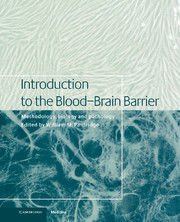Book contents
- Frontmatter
- Contents
- List of contributors
- 1 Blood–brain barrier methodology and biology
- Part I Methodology
- Part II Transport biology
- Part III General aspects of CNS transport
- Part IV Signal transduction/biochemical aspects
- Part V Pathophysiology in disease states
- 41 Cerebral amyloid angiopathy
- 42 Brain microvasculature in multiple sclerosis
- 43 Hemostasis and the blood–brain barrier
- 44 Microvascular pathology in cerebrovascular ischemia
- 45 HIV infection and the blood–brain barrier
- 46 Hypertension
- 47 The blood-brain barrier in brain tumours
- 48 The pathophysiology of blood–brain barrier dysfunction due to traumatic brain injury
- 49 Cerebral malaria and the brain microvasculature
- 50 Molecular basis of tissue tropism of bacterial meningitis
- Index
43 - Hemostasis and the blood–brain barrier
from Part V - Pathophysiology in disease states
Published online by Cambridge University Press: 10 December 2009
- Frontmatter
- Contents
- List of contributors
- 1 Blood–brain barrier methodology and biology
- Part I Methodology
- Part II Transport biology
- Part III General aspects of CNS transport
- Part IV Signal transduction/biochemical aspects
- Part V Pathophysiology in disease states
- 41 Cerebral amyloid angiopathy
- 42 Brain microvasculature in multiple sclerosis
- 43 Hemostasis and the blood–brain barrier
- 44 Microvascular pathology in cerebrovascular ischemia
- 45 HIV infection and the blood–brain barrier
- 46 Hypertension
- 47 The blood-brain barrier in brain tumours
- 48 The pathophysiology of blood–brain barrier dysfunction due to traumatic brain injury
- 49 Cerebral malaria and the brain microvasculature
- 50 Molecular basis of tissue tropism of bacterial meningitis
- Index
Summary
Introduction
Hemostasis and the blood–brain barrier (BBB) is a subject of growing interest. This increased emphasis is largely due to the appreciation of the importance of the endothelial cell as a mediator of hemostasis pathways. The unique milieu of brain capillary endothelial cells suggests a potentially important role of the BBB as a regulator of hemostasis. This chapter will provide a brief review of hemostasis pathways, and discuss the current state of knowledge of hemostasis factors and the BBB.
The traditional mode of analysis of the coagulation cascade focuses on distinct ‘intrinsic’ and ‘extrinsic’ pathways that lead toward clot formation. That view has gradually shifted to an understanding that is, paradoxically, at once increasingly simple and yet more complex. A current view of the coagulation cascade is shown in Fig. 43.1. Note that there is no distinction between ‘intrinsic’ and ‘extrinsic’ pathways; that paradigm is useful for the laboratory analysis of coagulation disorders, but has only limited in vivo relevance (Furie and Furie, 1992). Also note that the entire cascade is driven by tissue factor. Finally, it is important to appreciate that this coagulation cascade represents only part of the process regulating clot formation.
The coagulation cascade is initiated by tissue factor, an integral membrane protein expressed by nonvascular cells. The extracellular domain of tissue factor serves as a receptor for Factor VII, and the tissue factor–VIIa complex then activates Factors IX and X (Furie and Furie, 1992).
- Type
- Chapter
- Information
- Introduction to the Blood-Brain BarrierMethodology, Biology and Pathology, pp. 401 - 408Publisher: Cambridge University PressPrint publication year: 1998
- 1
- Cited by



